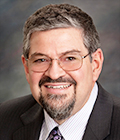
Mike Schweitzer, M.D., M.B.A.
Health care is moving from a fee-based to a value-based approach in which reimbursement has been a focus despite the key role of patient management in the change. A Self-Study course available for CME during the ANESTHESIOLOGY 2016 annual meeting focuses on changes in patient management in the value environment.
Kiosks to complete Self-Study courses are available outside Room 190, on level 1 of McCormack Place. The courses also will be available online after the meeting, but users cannot earn CME.
“Anesthesia Practices Improving Population Health” defines population health and population medicine, and then how anesthesia can help patients change their lifestyles to make a long-term impact on their health, said Mike Schweitzer, M.D., M.B.A., Chair of the ASA Committee on Future Models of Anesthesia Practice.
“You have a unique, defined population — patients going through procedures and surgeries — and in that unique population you have a great opportunity to activate them for change,” said Dr. Schweitzer, Chief Medical Officer, Bundled Payments, Premier Inc., Clearwater, Florida. “Population health management is managing the care for a defined set of individuals with a goal of improving quality, efficiency and patient satisfaction, and lowering the cost trend for the overall group. That is a population as a whole community — a whole city or county or state.”
Anesthesiologists are positioned to help this population of patients prepare for their surgeries and procedures, and reduce complications and readmissions. The patients often have chronic diseases and have not realized these conditions have slowly taken over their lives.
“What most folks don’t realize is that to make a behavior change with a patient, you have to grab their attention,” Dr. Schweitzer said. “A chronic disease comes on gradually and gets worse gradually, but it does not grab the attention of the patient.
“But now, if a patient is facing a major procedure or surgery, suddenly they want to improve their outcomes after the procedure or surgery. This is an opportunity for anesthesia to become involved with population medicine and say, ‘This is how you are going to have to change your behavior.’”
Using population health management concepts, anesthesiologists can identify patients most at risk and help them better manage their conditions. For example, if a patient has diabetes and his or her blood sugar is not controlled, helping them control their diabetes in the weeks before surgery can reduce the risk of infection and readmission.
“When you have established a relationship with these patients in the pre-op phase and then in the post-op discharge phase, you can reduce their complications, their emergency department visits and their readmissions,” Dr. Schweitzer said. “That is a critical time frame for these patients. It is just coordinated care for a specific, well-defined population.
“Without this coordinated care, it is like having all these Snapchat photos that are not connected, and we want them transformed into a YouTube video. What we are trying to do is coordinate their care over that 90-120 days before and after surgery so you have a YouTube video and all of that information is connected. This way, all of the care providers are connected and they are all in the same movie, and they know what is going on, which actually matters.”
Return to Archive Index